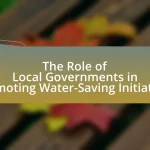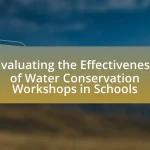Educational videos on water conservation for kids serve as engaging tools to teach children about the significance of saving water and practical methods to do so. These videos utilize animations, storytelling, and relatable characters to enhance understanding and retention of concepts such as the water cycle and sustainable practices. The article outlines the importance of water conservation for children, the role they play in conservation efforts, and the elements that make educational videos effective, including clear objectives, engaging visuals, and interactive components. Additionally, it discusses strategies for creating impactful videos, promoting them effectively, and incorporating viewer feedback to improve future content.
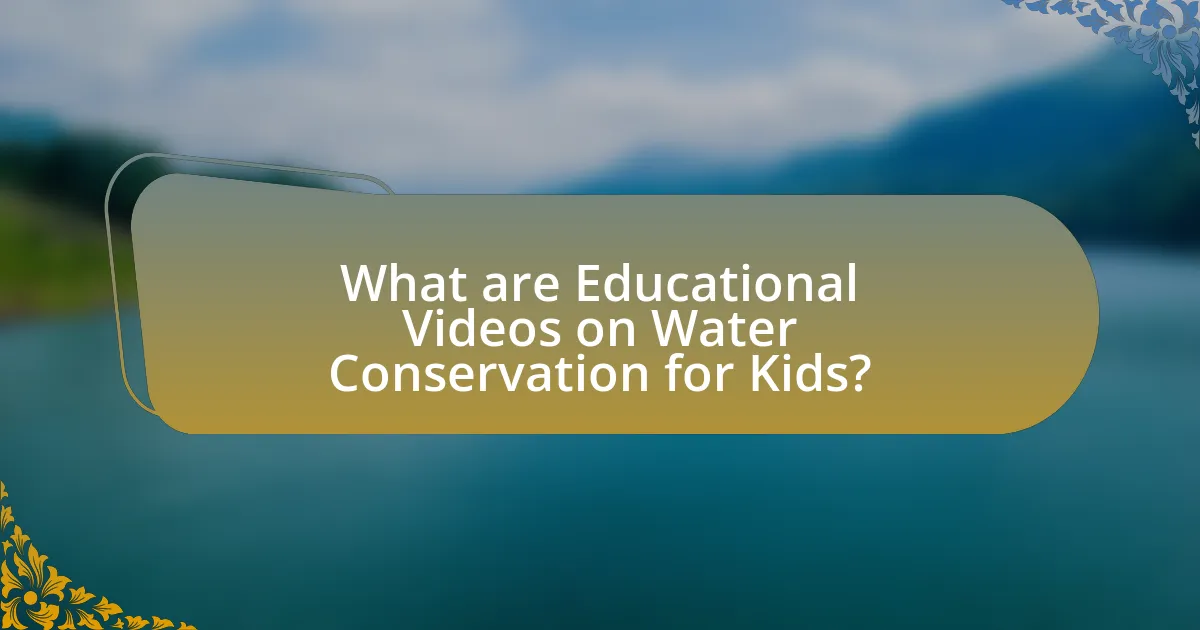
What are Educational Videos on Water Conservation for Kids?
Educational videos on water conservation for kids are engaging visual resources designed to teach children the importance of saving water and how to do it effectively. These videos often incorporate animations, storytelling, and relatable characters to capture children’s attention while conveying essential messages about water usage, the water cycle, and practical conservation tips. Research indicates that visual learning aids significantly enhance retention and understanding in young audiences, making these videos an effective educational tool.
Why is Water Conservation Important for Kids?
Water conservation is important for kids because it instills a sense of responsibility towards the environment and ensures the availability of clean water for future generations. Teaching children about water conservation helps them understand the finite nature of water resources; for instance, only 2.5% of the Earth’s water is freshwater, and a significant portion is locked in glaciers and ice caps. By learning to conserve water, kids can contribute to reducing water waste, which is crucial as the global demand for water is projected to increase by 55% by 2050. This knowledge empowers them to make informed choices, fostering a culture of sustainability that can lead to long-term environmental benefits.
How does understanding water conservation benefit children?
Understanding water conservation benefits children by instilling a sense of responsibility towards natural resources. This knowledge encourages children to adopt sustainable practices, such as reducing water waste and promoting recycling. Research indicates that early education on environmental issues, including water conservation, leads to long-term behavioral changes; for instance, a study published in the Journal of Environmental Education found that children who learn about conservation are more likely to engage in eco-friendly behaviors as adults. By grasping the importance of water conservation, children not only contribute to environmental sustainability but also develop critical thinking and problem-solving skills related to resource management.
What role do kids play in water conservation efforts?
Kids play a crucial role in water conservation efforts by actively participating in awareness campaigns and adopting sustainable practices. Their involvement can lead to significant changes in household water usage, as studies show that children influence family behaviors, often encouraging parents to implement water-saving measures. For instance, educational programs targeting children have demonstrated that when kids learn about the importance of conserving water, they are more likely to remind their families to turn off taps and fix leaks, resulting in reduced water consumption.
What Elements Make Educational Videos Effective?
Effective educational videos incorporate clear objectives, engaging visuals, concise content, and interactive elements. Clear objectives ensure that the viewer understands the purpose of the video, while engaging visuals capture attention and enhance retention. Concise content delivers information in a straightforward manner, making it easier for young audiences to grasp complex concepts. Interactive elements, such as quizzes or prompts for reflection, encourage active participation, which has been shown to improve learning outcomes. Research indicates that videos with these elements can increase viewer retention by up to 80%, demonstrating their effectiveness in educational contexts.
How can storytelling enhance the learning experience?
Storytelling enhances the learning experience by making complex concepts more relatable and memorable. When educational content is presented through narratives, it engages students emotionally and cognitively, facilitating better retention of information. Research indicates that stories activate multiple areas of the brain, including those responsible for language, sensory experiences, and emotions, which can lead to improved understanding and recall. For instance, a study published in the journal “Educational Psychology” found that students who learned through storytelling demonstrated a 20% increase in retention compared to those who received traditional instruction. This demonstrates that storytelling not only captures attention but also reinforces learning outcomes effectively.
What visual aids are most effective in teaching kids about water conservation?
Infographics and animated videos are the most effective visual aids in teaching kids about water conservation. Infographics simplify complex information into engaging visuals, making it easier for children to understand concepts like water usage and conservation methods. Animated videos capture attention and can illustrate scenarios, such as the water cycle or the impact of water waste, in a dynamic way. Research indicates that children retain information better when it is presented visually; for instance, a study published in the Journal of Educational Psychology found that visual aids can enhance learning retention by up to 65%.
What Topics Should Be Covered in These Videos?
Videos on water conservation for kids should cover the importance of water, the water cycle, practical water-saving tips, the impact of water waste on the environment, and fun experiments to demonstrate water conservation. These topics engage children by providing relatable content and actionable steps. For instance, teaching kids about the water cycle helps them understand where water comes from and why it is essential to conserve it. Practical tips, such as turning off the tap while brushing teeth, can be easily implemented in their daily lives. Additionally, discussing the environmental impact of water waste, such as droughts and habitat destruction, reinforces the significance of conservation efforts. Fun experiments, like measuring water usage in different activities, can make learning interactive and memorable.
What are the key concepts of water conservation for children?
The key concepts of water conservation for children include understanding the importance of saving water, recognizing ways to reduce water usage, and learning about the water cycle. Children should be taught that water is a limited resource essential for life, and they can contribute by turning off taps while brushing teeth, taking shorter showers, and using water-efficient appliances. Additionally, engaging activities like tracking water usage at home can reinforce these concepts. Studies show that early education on environmental issues, including water conservation, leads to more sustainable behaviors in adulthood, highlighting the effectiveness of teaching these principles to children.
How can real-life examples be incorporated into the videos?
Real-life examples can be incorporated into the videos by showcasing practical scenarios where water conservation is applied, such as demonstrating how families reduce water usage in daily activities like showering or gardening. For instance, a video could feature a family using a rain barrel to collect rainwater for irrigation, illustrating the concept of water recycling. This approach not only makes the content relatable but also provides tangible evidence of effective water-saving practices, reinforcing the educational message.
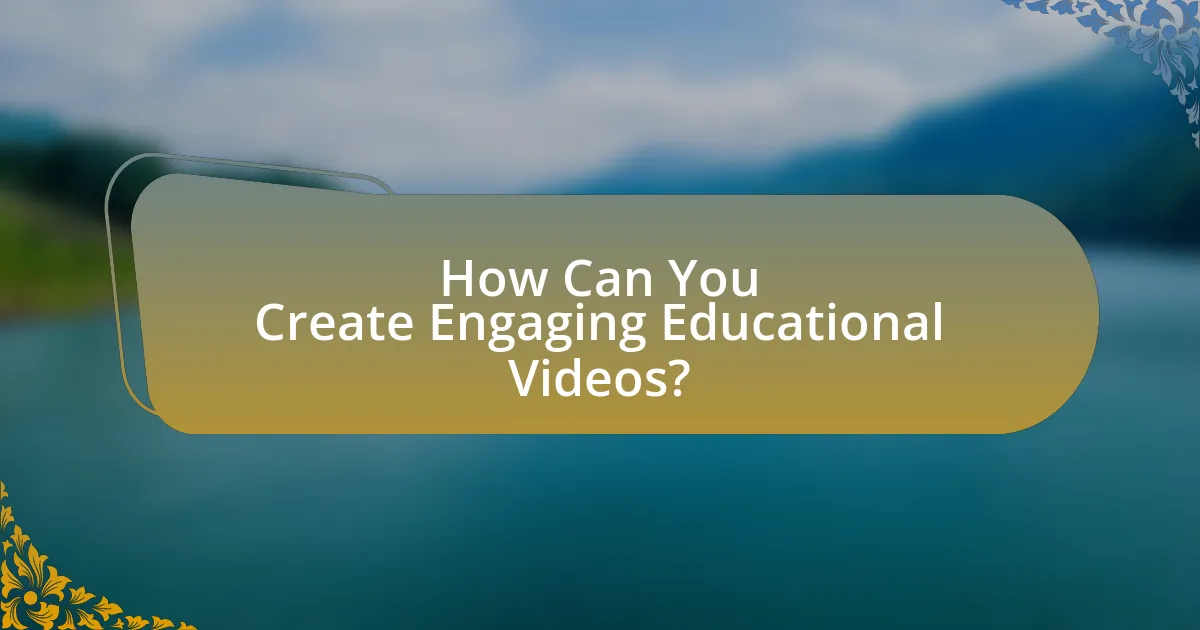
How Can You Create Engaging Educational Videos?
To create engaging educational videos, focus on clear storytelling, interactive elements, and visually appealing content. Clear storytelling involves presenting information in a structured manner that captures attention and maintains interest. Incorporating interactive elements, such as quizzes or prompts for viewer participation, enhances engagement by encouraging active learning. Visually appealing content, including animations and colorful graphics, can help illustrate concepts effectively, making them more relatable and easier to understand for children. Research indicates that videos with a combination of these elements can increase retention rates by up to 80%, demonstrating their effectiveness in educational contexts.
What Tools and Resources Are Needed for Video Creation?
To create educational videos on water conservation for kids, essential tools and resources include a high-quality camera, video editing software, and a script or storyboard. A high-quality camera, such as a DSLR or a smartphone with a good camera, ensures clear visuals, which are crucial for engaging young audiences. Video editing software, like Adobe Premiere Pro or iMovie, allows for the incorporation of graphics, sound effects, and transitions, enhancing the overall production quality. A well-structured script or storyboard guides the content flow, ensuring that the message about water conservation is communicated effectively and is age-appropriate.
Which software is best for editing educational videos?
The best software for editing educational videos is Adobe Premiere Pro. This professional-grade video editing software offers a wide range of features, including advanced editing tools, audio editing capabilities, and support for various video formats, making it suitable for creating high-quality educational content. Additionally, Adobe Premiere Pro is widely used in the industry, which ensures a wealth of tutorials and community support for users.
What equipment is essential for filming high-quality videos?
Essential equipment for filming high-quality videos includes a high-definition camera, a tripod, external microphones, and proper lighting. A high-definition camera, such as a DSLR or mirrorless camera, captures clear and detailed footage, which is crucial for engaging educational content. A tripod stabilizes the camera, preventing shaky shots that can distract viewers. External microphones enhance audio quality, ensuring that dialogue and sounds are crisp and clear, which is vital for educational videos. Proper lighting, whether through natural light or artificial sources, illuminates the subject effectively, improving the overall visual quality. These components collectively contribute to producing professional-looking videos that effectively convey educational messages.
How Can You Make Videos Interactive for Kids?
To make videos interactive for kids, incorporate elements such as quizzes, polls, and clickable choices that engage viewers actively. Research shows that interactive content increases retention rates by up to 70%, making it effective for educational purposes. For instance, using platforms like Edpuzzle allows creators to embed questions directly into videos, prompting kids to think critically about water conservation concepts while watching. This method not only maintains attention but also reinforces learning through immediate feedback.
What techniques can be used to encourage viewer participation?
To encourage viewer participation in educational videos on water conservation for kids, interactive elements such as quizzes, polls, and challenges can be effectively utilized. These techniques engage young viewers by prompting them to think critically about the content and apply what they have learned. For instance, incorporating a quiz at the end of the video can reinforce key concepts and encourage kids to reflect on their understanding. Research shows that interactive content increases engagement rates by up to 70%, making it a powerful tool for educational purposes. Additionally, using storytelling and relatable characters can enhance emotional connection, further motivating kids to participate actively in discussions or activities related to water conservation.
How can quizzes and activities be integrated into the videos?
Quizzes and activities can be integrated into videos by using interactive video platforms that allow for embedded questions and tasks at specific points in the video. These platforms enable creators to pause the video and prompt viewers with quizzes related to the content just presented, enhancing engagement and retention. For example, tools like Edpuzzle or H5P facilitate this integration by allowing educators to insert multiple-choice questions, true/false questions, or even short answer prompts directly into the video timeline. Research shows that interactive elements in educational videos can increase viewer retention rates by up to 60%, making this approach effective for teaching concepts like water conservation to kids.
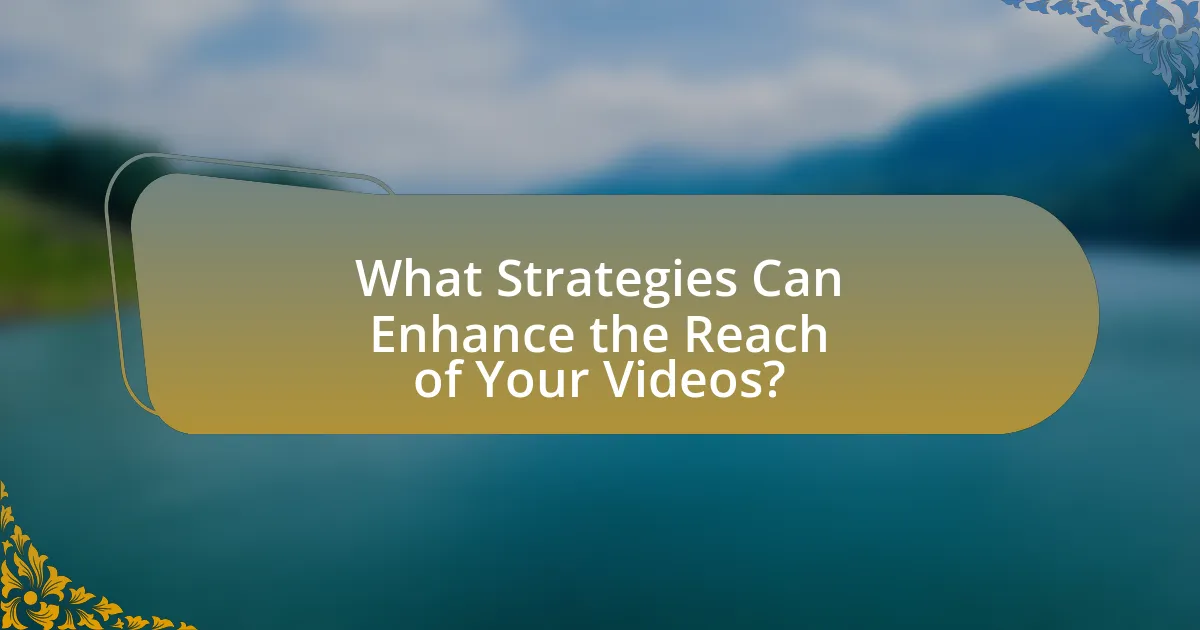
What Strategies Can Enhance the Reach of Your Videos?
To enhance the reach of your videos on water conservation for kids, utilize social media platforms effectively. Sharing videos on platforms like Facebook, Instagram, and TikTok can significantly increase visibility, as these platforms have billions of active users. For instance, videos that are optimized for mobile viewing and include engaging thumbnails can attract more clicks; studies show that videos with compelling thumbnails can increase click-through rates by up to 30%. Additionally, collaborating with influencers in the education or environmental sectors can expand your audience, as their followers may be interested in your content. Engaging with viewers through comments and encouraging shares can also foster community interaction, further amplifying reach.
How Can You Promote Your Educational Videos Effectively?
To promote your educational videos effectively, utilize social media platforms to reach a wider audience. Platforms like Facebook, Instagram, and YouTube have billions of active users, making them ideal for sharing content. For instance, a study by Pew Research Center indicates that 73% of adults use YouTube, which can significantly enhance visibility for educational content. Additionally, engaging with communities focused on water conservation can foster interest and encourage sharing. Collaborating with influencers in the education or environmental sectors can also amplify your reach, as they can introduce your videos to their established audiences.
What social media platforms are best for sharing educational content?
The best social media platforms for sharing educational content are YouTube, Facebook, Instagram, and TikTok. YouTube is widely recognized for its extensive reach and video-centric format, making it ideal for educational videos. Facebook allows for community engagement and sharing of diverse content types, while Instagram’s visual focus is effective for quick educational snippets. TikTok’s short-form video format has gained popularity for engaging younger audiences with educational content in a fun and creative way. These platforms collectively support various content styles and audience interactions, enhancing the dissemination of educational material.
How can partnerships with schools enhance video visibility?
Partnerships with schools can enhance video visibility by providing access to a larger audience of students, teachers, and parents. When educational institutions collaborate on video projects, they can integrate these resources into their curricula, ensuring that the videos reach students directly during lessons. For instance, a study by the National Education Association found that educational partnerships can increase engagement and retention of information, leading to higher viewership of educational content. Additionally, schools often promote such collaborations through newsletters, social media, and events, further amplifying the video’s reach within the community.
What Feedback Mechanisms Can Be Implemented?
Feedback mechanisms that can be implemented include surveys, quizzes, and interactive discussions. Surveys can gather viewer opinions on the educational content, allowing for quantitative data collection on engagement and understanding. Quizzes can assess knowledge retention and comprehension of water conservation concepts presented in the videos, providing immediate feedback to both educators and students. Interactive discussions, whether in-person or online, can facilitate real-time feedback and encourage dialogue, enhancing the learning experience. These mechanisms are effective as they provide actionable insights that can improve future video content and teaching strategies.
How can viewer feedback improve future video content?
Viewer feedback can significantly enhance future video content by providing insights into audience preferences and engagement levels. Analyzing comments, ratings, and view duration allows creators to identify which aspects of the videos resonate most with viewers, such as specific topics or presentation styles. For instance, a study by the Pew Research Center found that 73% of teens reported that they learn better through video content, indicating the importance of aligning educational material with viewer interests. By incorporating this feedback, content creators can tailor their videos to be more engaging and effective, ultimately improving educational outcomes in topics like water conservation for kids.
What metrics should be tracked to measure video effectiveness?
To measure video effectiveness, key metrics include view count, engagement rate, retention rate, and conversion rate. View count indicates the total number of times the video has been watched, providing a basic measure of reach. Engagement rate, calculated through likes, shares, and comments, reflects how well the content resonates with the audience. Retention rate shows the percentage of viewers who watch the video to completion, highlighting its ability to maintain interest. Conversion rate tracks the number of viewers who take a desired action, such as signing up for a newsletter or participating in a water conservation program, demonstrating the video’s impact on behavior. These metrics collectively provide a comprehensive understanding of a video’s performance and effectiveness in educating children about water conservation.
What Are Some Best Practices for Creating Educational Videos on Water Conservation for Kids?
To create effective educational videos on water conservation for kids, focus on engaging storytelling, clear visuals, and interactive elements. Engaging storytelling captures children’s attention and makes the content relatable, while clear visuals help illustrate concepts like the water cycle or conservation methods. Incorporating interactive elements, such as quizzes or challenges, encourages active participation and reinforces learning. Research indicates that children retain information better when they are actively involved in the learning process, making these practices essential for effective educational content.

